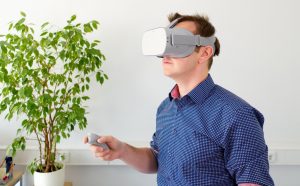By Chris Hornung, Managing Director of Public Sector Business at Totalmobile
In recent months, there’s been a lot of hot debate about how the Metaverse is set to transform how we work, play, shop, socialise, transact, and more.
Featuring the confluence of multiple technologies including 5G, artificial intelligence (AI), the internet of things, blockchain, virtual and augmented reality, 3D graphics, machine learning, VR-enabled headsets, and quantum computing, the Metaverse aspires to provide highly immersive and embodied online experiences. So far, so good. But what does all this marketing speak really mean?
Essentially, the Metaverse builds on ‘old school’ digital gaming concepts to enable highly responsive virtual and augmented reality spaces where users can virtually meet, work, learn – and potentially gain access to public services.
 Indeed, according to Mark Zuckerberg, co-founder and chief executive of Meta (aka Facebook), the Metaverse is “an embodied Internet where you’re in an experience, not just looking at it.” If you’ve seen the film The Matrix, you’ll have some understanding of the scope and ambition of the Metaverse vision: a virtual digital world in which people can live out their daily lives via avatars.
Indeed, according to Mark Zuckerberg, co-founder and chief executive of Meta (aka Facebook), the Metaverse is “an embodied Internet where you’re in an experience, not just looking at it.” If you’ve seen the film The Matrix, you’ll have some understanding of the scope and ambition of the Metaverse vision: a virtual digital world in which people can live out their daily lives via avatars.
If that all sounds a bit like far-fetched science fiction, then think again. Because the art world is already experimenting with NFTs (non-fungible tokens) that represent a unique digital representation of a work of art. Indeed, many art investors are betting that NFTs will revolutionise how art is viewed, owned, and traded.
From fiction to fact – going beyond the hype
For the past two decades, the online gaming world has been pushing forward the boundaries of what is possible where gamification, immersive virtual experiences, and alternative worlds are concerned. However, recent developments in super computing – combined with digital blockchain and decentralised Web3 technologies – are now set to unlock the true potential of Metaverse platforms. Delivering a new era of real-time interactive 3D digital human experiences and simulations that go far beyond how we interact virtually today.
Unsurprisingly, big tech and gaming companies are hoping to play a leading role in shaping the Metaverse future while capturing a market lead in what’s hotly anticipated to be the ‘next big thing’. Indeed, it’s the reason why Facebook took the decision to rebrand itself as Meta in 2021.
But with so much being written about Metaverse potential use cases, to all practical intents the Metaverse today remains very much a clunky ‘work in progress’. Plus, there has been much debate about whether consumers will be ready and willing to interact, transact, and participate in these eagerly anticipated new digital ecosystems.
One thing is for sure. Alongside addressing a lot of tech-related interoperability challenges, kickstarting the mass take up of the next generation of Metaverse experiences will be dependent on the development of new legal frameworks and regulatory rules that will protect users in these virtual worlds. Unsurprisingly, issues like user privacy, data protection, digital ID, ethics, and cybersecurity are all top concerns, especially where children and young or vulnerable adults are concerned.
Which is why agencies like the UK government’s Digital Catapult are bringing together key stakeholders from industry, academia, and regulatory authorities to examine how best to support Metaverse innovations, while ensuring that ‘safety by design’ standards are embedded into Metaverse platforms and technologies.
Think evolution, rather than revolution
For government and public sector organisations, the Metaverse can seem like a significant leap from a service delivery perspective. The good news is that there’s no need to decide whether or not to buy a Metaverse ticket and get on the train right now. However, being aware of the technologies and products that are set to shape the future of UK digital service delivery is no bad thing.
In the past two years, government and public sector organisations have undergone rapid digitalisation that’s transformed service delivery and citizen/user interactions. In parallel, many organisations have begun experimenting with powerful virtualisation and cloud distribution technologies to deliver new immersive experiences in a variety of fields – think online digital exhibitions and arts catalogues, or digital twins and learning and digital skills programmes.
In the future, chatbots and virtual digital assistants that are now everyday features of contact and support centres may be supplemented by online virtual assistants that ‘meet’ and help service users in the Metaverse. Meanwhile, remote employees can literally meet colleagues in the Metaverse or join virtual immersive representations of their workplace/office.
Providing a potentially rich opportunity to enhance communication and engagement with citizens and service users, the Metaverse is a book that’s waiting to be written. Offering the potential to revolutionise healthcare, education, tourism, smart cities, social and political engagement, and more, initially most organisations will first look to harness the benefits of the Metaverse to enhance traditional processes and improve citizen centricity. After which, the deployment of universal digital platforms that support individuals and commercial entities in new and highly distributed ways may see the Metaverse expanding in new and unexpected ways.






Recent Comments